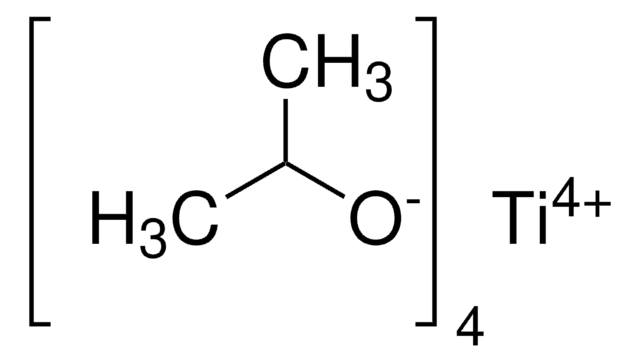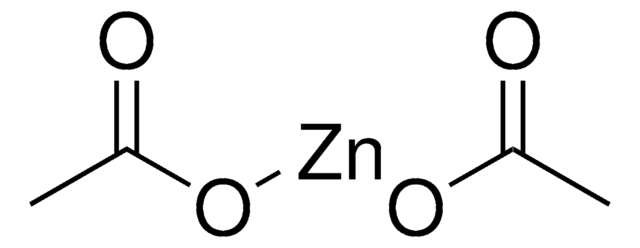356018
Zinc
foil, thickness 0.25 mm, 99.9% trace metals basis
Synonym(s):
Zn
Sign Into View Organizational & Contract Pricing
All Photos(1)
About This Item
Empirical Formula (Hill Notation):
Zn
CAS Number:
Molecular Weight:
65.39
EC Number:
MDL number:
UNSPSC Code:
12161600
PubChem Substance ID:
NACRES:
NA.22
Recommended Products
vapor pressure
1 mmHg ( 487 °C)
Quality Level
Assay
99.9% trace metals basis
form
foil
reaction suitability
core: zinc
reagent type: catalyst
resistivity
5.8 μΩ-cm, 20°C
thickness
0.25 mm
bp
907 °C (lit.)
mp
420 °C (lit.)
density
7.133 g/mL at 25 °C (lit.)
SMILES string
[Zn]
InChI
1S/Zn
InChI key
HCHKCACWOHOZIP-UHFFFAOYSA-N
Related Categories
Application
Zinc can be used as a catalyst:
- For the reduction of nitrobenzenes to aniline derivatives in the presence of ammonium chloride.
- To synthesize β-hydroxy esters using ketones and α-bromoacetates via Reformatsky reaction.
- For the transesterification of ethyl acetate and benzyl alcohol to synthesize benzyl acetate in the presence of imidazole.
Quantity
- 50 × 50 mm (approximately 4.5 g)
- 100 × 100 mm (approximately 18 g)
Storage Class Code
11 - Combustible Solids
WGK
WGK 3
Personal Protective Equipment
dust mask type N95 (US), Eyeshields, Gloves
Choose from one of the most recent versions:
Already Own This Product?
Find documentation for the products that you have recently purchased in the Document Library.
Rapid and convenient conversion of nitroarenes to anilines under microwave conditions using nonprecious metals in mildly acidic medium
Keenan C, et al.
Synthetic Communications, 47, 1085-1089 (2017)
Shigeki Seto et al.
Bioorganic & medicinal chemistry, 20(3), 1188-1200 (2012-01-21)
The design, synthesis, and evaluation of 6-6-7 tricyclic quinolones containing the strained spirocycle moiety aiming at the GSK-3β inhibitor were described. Among the synthesized compounds, 44, having a cyclobutane ring on a spirocycle, showed excellent GSK-3β inhibitory activity in both
Transesterification reactions catalyzed by a recyclable heterogeneous zinc/imidazole catalyst
Nakatake D, et al.
advanced synthesis and catalysis, 358, 2569-2574 (2016)
Sara Eyal et al.
Journal of nuclear medicine : official publication, Society of Nuclear Medicine, 50(5), 798-806 (2009-05-01)
Studies in rodents indicate that the disruption of P-glycoprotein (P-gp) function increases drug distribution into the developing fetus and organs such as the brain. To simultaneously and serially evaluate the effect of P-gp activity and inhibition on the tissue distribution
A viewpoint about the treatment of Wilson's disease.
Abdul Qayyum Rana et al.
The Canadian journal of neurological sciences. Le journal canadien des sciences neurologiques, 40(4), 612-614 (2013-06-22)
Our team of scientists has experience in all areas of research including Life Science, Material Science, Chemical Synthesis, Chromatography, Analytical and many others.
Contact Technical Service




